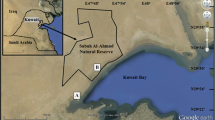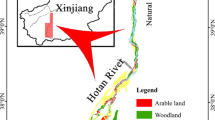Abstract
Cynanchum registanense Jayanthi is a rare threatened species of the arid region which needs conservation efforts. We report here its diversity in nature and efficacy of traditional rainwater conservation structure, i.e., half-moon terrace (HMT) in accelerating plant regeneration and population buildup as well as in situ conservation. Two biotypes of C. registanense found in nature are (i) common on rocky crevices having crisped margin leaves with light yellow flowers, and (ii) growing on sand deposition having leaf margin entire and dark yellow flowers. Ecologically, it is a subdominant species with relative importance values ranging from 8.71 to 49. Monitoring plant population and growth parameters for 3 years showed that the HMT conserving sufficient rainwater quantities successfully regenerated plants of C. registanense. Box-whisker plots revealed relatively high annual variability of the plant populations and high median values in four quadrats situated closer to the embankment of HMT as compared to those located away from the embankment. Comparing mean plant populations between adjacent pairs of quadrats using a t-test revealed that C. registanense regenerating within 5 m of HMT embankment flourished better than those growing farther away. Plant population showed a moderately positive linear relationship (R2 = 0.30), significant at p < 0.10. It was further revealed that a minimum of 27 mm rainfall spread over 6-day period is essential for conserving C. registanense. Overall, findings of this study proved existence of variability in habitat-specific C. registanense in arid region of western Rajasthan, which could be conserved in situ and enhanced in its density by a traditional rainwater conservation method.









Similar content being viewed by others
References
Ali T, Ali SI (1996a) Andromonoecy in Glossonema varians (Stocks) Hook.f. (Asclepiadaceae). Pak J Bot 28:25–29
Ali T, Ali SI (1996b) Effect of sugar concentration on pollinium germination in some members of Asclepiadaceae. Pak J Bot 28:161–165
Barik SK, Tiwari ON, Adhikari D, Singh PP, Tiwary R, Barua S (2018) Geographic distribution pattern of threatened plants of India and steps taken for their conservation. Curr Sci 114(3):470–503
Bhandari MM (1990) Flora of the Indian Desert. MPS Repros, Rajasthan
CBD (2010) Global strategy for plant conservation: technical rationale, justification for updating and suggested milestone and indicators. In: Conference of Parties to the Convention on Biological Diversity. Tenth Meeting. UNEP/CBD/COP, Nagoya, Japan
Curtis JT, McIntosh RP (1950) The inter relationships of certain analytic and synthetic phytosociological characters. Ecology 31:434–455
Dinerstein E, Olson D, Joshi A, Vynne C, Burgess ND, Wikramanayake E, Hahn N, Palminteri S, Hedao P, Hedao P, Noss R, Hansen M, Locke H, Ellis EC, Jones B, Barber CV, Hayes R, Kormos C, Martin V et al (2017) An ecoregion based approach to protecting half the terrestrial realm. Bioscience 67(6):534–545
Faroda AS, Kumar S (1997) Biodiversity in arid zone: priorities and strategies for its conservation. Agro’s Annual Rev Crop Ecol 1:163–170
Gupta JP, Gupta GN (1983) Effect of grass mulching on growth and yield of legumes. Agric Water Manag 6:375–383
Kagi C, Petitpierre B, Meyer P, Lötscher Y, Eggenberg S, Aubry S (2023) Fostering in situ conservation of wild relatives of forage crops. Front Plant Sci 14. https://doi.org/10.3389/fpls.2023.1287430
Khan TI (1996) Biodiversity depletion with respect to human and livestock population in Indian desert. In: West NE (ed) Rangelands in a sustainable biosphere 1. Society for Rangeland Management, Denver, CO, USA, pp 286–287
Kulloli RN, Kumar S (2014) Commiphora wightii (Arnott.) Bhandari in the Indian desert: biology, distribution and threat status. In: Nandwani D (ed) Sustainable Horticultural Systems : Issues, Technologies and Innovations. Springer Verlag, Amsterdam, pp 301–313
Kulloli RN, Kumar S, **dal SK (2013) Ex-situ conservation of an arid threatened species Commiphora wightii (Arnt.) Bhand. through seeds. J Trop Forestr 29(6):15–22
Kulloli RN, Mathur M, Kumar S (2016) Dynamics of top-down factors with relation to ecological attributes of an endangered species: Commiphora wightii. J Appl Nat Sci 8(3):1556–1564
Kulloli RN, Kumar S, Mathur M, Purohit CS (2009) Assessment of variability in Guggal in the Indian Arid zone. In: Abstracts of “International Conference on Nurturing Arid Zones for people and the Environment: Issues and Agenda for the 21st Century” on 24-28th November 2009 at CAZRI, Jodhpur, p 163
Kumar S, Purohit CS, Kulloli RN (2014) Seed germination trends in threatened desert species. In: Sharma A, Chaubay OP, Ramprakash (eds) Tree Seed Technology and seed pathology. Pointer Publisher, Jaipur, pp 6–22
Kumar S (2002) Regional biodiversity profiles: arid and semi arid areas. In: Singh JS (ed) National Biodiversity Strategy and Action Plant – National Terrestrial Ecosystem. Banaras Hindu University, Varanasi, U.P., pp 292–306
Kumar S (2016) Biodiversity and its conservation in climate change scenario. In: Bhatt RK, Burman U, Painuli DK, Singh DV, Sharma R, Tanwar SPS (eds) Climate Change and Agriculture: Adaptation and Mitigations. Satish Serial Publishing House, New Delhi, India, pp 107–122
Kumar S, Purohit CS (2015) Conservation of threatened desert plants. Scientific Publishers, Jodhpur, India, p 162
Kumar S, Singh G, Parmar PJ, Pandey RP, Sharma SC, Sunadaramoorthy S, Singh JP, Kasera P, Purohit CS, Sen DN (2009) Plant diversity conservation for sustainability. In: Kar A, Garg BK, Singh MP, Kathju S (eds) Trends in Arid Zone Research in India. Central Arid Zone Research Institute Jodhpur, pp 151–179
Kumar S, Purohit CS, Kulloli RN (2010) Ex-situ conservation of rare plant - Moringa concanensis Nimmo ex Dalz. & Gibs. J Econ Taxon Bot 34(3):693–698
Kumar S, Purohit CS, Kulloli RN (2011) Cullen plicata: a rare leguminous plant and its conservation efforts. J Arid Legumes 8:18–22
Kumar S, Purohit CS, Kulloli RN (2016) Rarity of Ceropegia bulbosa Roxb. var. lushii and protocol for its ex-situ conservation in the Indian desert. J Appl Nat Sci 8(4):2155–2163
Kumar S, Purohit CS, Kulloli RN (2017) Ex-situ conservation of threatened plants in the Indian Desert Botanical Garden, CAZRI, Jodhpur. In: Singh P, Ghosh SS (eds) Indian Botanic Gardens Role in Conservation. Botanical Survey of India, pp 406–425
Kumar S, Azam MM, Venkatesan K, Pancholy A, Kulloli RN (2019) Morphological and biochemical variability in Aloe germplasm in hot arid region of India. J Herbs, Spices Med Plants 25(2):158–171
Lauterbach D, Burkart M, Gemeinholzer B (2012) Rapid genetic differentiation between ex-situ and their in-situ source populations: an example of the endangered Silene otites (Caryophyllaceae). Bot J Linn Soc 168:64–75
Lughadha EN, Bachman SP, Leão TCC (2020) Extinction risk and threats to plants and fungi. Plants, People, Planet 2(5):389–408
Machiwal D, Jha MK (2012) Hydrologic time series analysis: theory and practice. Springer, Netherlands and Capital Publishing Company, New Delhi, India, p 303
Machiwal D, Kar A, Joshi DC, Yadav KK (2023) Land and water resource management in the Thar Desert region. In: Varghese N, Burark SS, Varghese KA (eds) Natural Resource Management in the Thar Desert Region of Rajasthan. Springer, Switzerland, pp 73–100
Machiwal D, Kumar S, Dayal D, Mangalassery S (2017) Identifying abrupt changes and detecting gradual trends of annual rainfall in an Indian arid region under heightened rainfall rise regime. Int J Climatol 37(5):2719–2733
Meena HM, Machiwal D, Santra P, Moharana PC, Singh DV (2019) Trends and homogeneity of monthly, seasonal and annual rainfall over arid region of Rajasthan, India. Theor Appl Climatol 136:795–811
Moharana PC, Goyal RK, Machiwal D, Pandey CB (2022) Impact assessment of indigenous field-level water storage structure (diggi) on agriculture in the great Indian desert. Environ Earth Sci 81:284. https://doi.org/10.1007/s12665-022-10394-w
Ojaswi PR, Goyal RK, Gupta JP (1999) The micro-catchment water harvesting technique for the plantation of jujube (Zizyphus mauritiana) in an agroforestry system under arid conditions. Agric Water Manag 41:139–147
Panda PC, Kumar S, Gajurel P, Kamila PK, Kashung S, Kulloli RN, Singh PP, Adhikari D, Barik SK (2018) Improving macropropagation and seed germination techniques for conservation of threatened species. Curr Sci 114(3):562–564
Panwar P, Machiwal D, Kumari V, Kumar S, Dogra P, Manivannan S, Bhatnagar PR, Tomar JMS, Kaushal R, **ger D, Sarkar PK, Baishya LK, Devi NP, Kakade V, Singh G, Singh NR, Singh SG, Patel A, Renjith PS et al (2023) Sustainable water harvesting for improving food security and livelihoods of smallholders under different climatic conditions of India. Sustainability 15(12):9230. https://doi.org/10.3390/su15129230
Parihar S, Dwivedi NK (2020) A note on an important edible rare and the famine food plant of Indian Thar Desert: Glossonema varians (Stocks) Benth. ex Hook.f. Genetic Resour Crop Evol 67(7):1929–1934
Regar PL, Rao SS, Joshi NL (2009) Effect of in-situ moisture conservation practices on productivity of rainfed taramira (Eruca sativa) in arid Rajasthan. Indian J Soil Conserv 37(3):197–200
Sharma KD, Pareek OP, Singh HP (1986) Microcatchment water harvesting for raising jujube orchards in an arid climate. Trans Am Soc Agric Eng 29:112–118
Shetty BV, Singh V (1991) Flora of Rajasthan, Volume-2. Botanical Survey of India, Kolkata, p 482
Singh JP, Kumar S, Kulloli RN (2017) Glossonema varians: a threatened food cum medicinal plant of western Rajasthan. Indian J Arid Horticult 12(1&2):16–18
Singh JP, Kumar S, Venkatesan K, Kulloli RN (2016) Conservation status and utilization of Caralluma edulis: an important threatened medicinal plant species of the Thar Desert, India. Genetic Resour Crop Evol 63:721–732
Snedecor GW, Cochran WG (1980) Statistical methods. Iowa State University Press, Ames, Iowa
Tewari VP, Arya R (2004) Degradation of arid rangelands in Thar Desert, India: a review. Arid Land Res Manag 19(1):1–12
Vincent H, Amri A, Castaneda-Alvarez N, Dempewolf H, Dulloo E, Guarino L, Hole D, Mba C, Toledo A, Maxted N (2019) Modeling of crop wild relative species identifies areas globally for in situ conservation. Commun Biol 2(1). https://doi.org/10.1038/s42003-019-0372-zc
Vischi N, Natale E, Villamil C (2004) Six endemic plant species from central Argentina: an evaluation of their conservation status. Biodiver Conserv 13:997–1008
Whitlock R, Hipperson H, Thompson DBA, Butlin RK, Burke T (2016) Consequences of in-situ strategies for the conservation of plant genetic diversity. Biol Conserv 203:134–142
Wiens J (2016) Climate related localextinctions are already widespread among plant and animal species. Plos Biol 14(12). https://doi.org/10.1371/journal.pbio.2001104
Acknowledgements
The authors are grateful to the Director, ICAR-Central Arid Zone Research Institute, Jodhpur, India, for providing the necessary facilities to conduct the experiment.
Funding
Financial support was received from the Department of Biotechnology, New Delhi, India, through the All India Coordinated Project on Preventing Extinction and Improving Conservation Status of Threatened Plants through the Application of Biotechnological Tools.
Author information
Authors and Affiliations
Contributions
S.K. and J.P.S. performed the research tasks and edited the draft of the manuscript.
D.M. synthesized data and edited draft of the manuscript and revised the manuscript.
R.K.K. collected and analyzed plant samples, recorded data, and drafted and edited the manuscript. S.K.B. supervised the research works and reviewed the manuscript.
Corresponding author
Ethics declarations
Ethics Approval
Not applicable
Competing Interests
The authors declare no competing interests.
Additional information
Publisher’s Note
Springer Nature remains neutral with regard to jurisdictional claims in published maps and institutional affiliations.
Rights and permissions
Springer Nature or its licensor (e.g. a society or other partner) holds exclusive rights to this article under a publishing agreement with the author(s) or other rightsholder(s); author self-archiving of the accepted manuscript version of this article is solely governed by the terms of such publishing agreement and applicable law.
About this article
Cite this article
Kumar, S., Singh, J.P., Machiwal, D. et al. In Situ Rainwater Conservation Through Half-Moon Terraces for Sustaining C. registanense in the Indian Thar Desert. Water Conserv Sci Eng 9, 28 (2024). https://doi.org/10.1007/s41101-024-00261-z
Received:
Accepted:
Published:
DOI: https://doi.org/10.1007/s41101-024-00261-z




